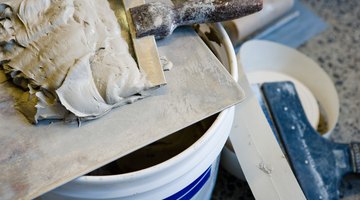The Plastic Bag Technique for Drywall Texture
A simple plastic bag can create texture when pressed into wet drywall compound. Texture hides wall imperfections such as bulging drywall seams or rough surfaces. The texture is often used on ceilings, because it is very difficult to have a perfect drywall installation.

Besides being visually interesting, textured drywall acts as a sound barrier in rooms with hard floors and high ceilings.
Plastic Type
Though any plastic will work, some forms are better than others. Use the thinnest plastic sheeting you can find and crumple it up into a small ball. If you are using garbage bags, the less expensive versions are often thinner and create a more visually appealing texture. The thicker plastics generally create large indentions and do not look as professional. If you are using grocery bags, always turn the bag inside out, so the print is in the inside of the bag.
Method
Roll joint compound onto your drywall surface. Stamp the plastic bag into the wet plaster to create texture. Wear gloves when creating texture to prevent the plaster from drying on your hands. Have plenty of bags or plastic available. Eventually, the plastic becomes saturated with plaster, and a new bag must be used. Make sure you turn the crumpled plastic bag each time you make a new impression so you are not making the same imprint repeatedly on the wall.
Finishing Techinques
Once the entire surface is covered with plaster and stamped, allow the finish to dry about 24 hours. Lightly sand the surface with light grit sandpaper to remove any lose drywall crumbs. Using a roller made for textured surfaces, paint the surface with one coat of primer and then follow with one to two coats of latex paint.
Glaze
Glaze is an optional finish often added over hand applied finishes, such as the plastic bag technique. Mix together one part paint and three parts glaze. Often, a dark umber paint will create an antique and distressed look. Brush on glaze over the textured surface. Use a terry towel to pat the surface, pushing the glaze into the crevices created by the plastic bag.
The Drip Cap
- A simple plastic bag can create texture when pressed into wet drywall compound.
- Texture hides wall imperfections such as bulging drywall seams or rough surfaces.
- Using a roller made for textured surfaces, paint the surface with one coat of primer and then follow with one to two coats of latex paint.
- Mix together one part paint and three parts glaze.
- Brush on glaze over the textured surface.
References
- “The Complete Guide to Finishing Walls and Ceilings”; Tom Lemmer; 2006
- “Installing and Finishing Drywall”; William Spence; 2008
Writer Bio
Julie Hampton has worked as a professional freelance writer since 1999 for various newspapers and websites including "The Florida Sun" and "Pensacola News Journal." She served in the U.S. Army as a combat medic and nurse for over six years and recently worked as the Community Relations Director for a health center. Hampton studied journalism and communications at the University of West Florida.
Photo Credits
- Jupiterimages/Photos.com/Getty Images
- Jupiterimages/Photos.com/Getty Images
More Articles



